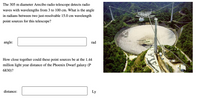
College Physics
11th Edition
ISBN: 9781305952300
Author: Raymond A. Serway, Chris Vuille
Publisher: Cengage Learning
expand_more
expand_more
format_list_bulleted
Concept explainers
Question

Transcribed Image Text:The 305 m diameter Arecibo radio telescope detects radio
waves with wavelengths from 3 to 100 cm. What is the angle
in radians between two just-resolvable 15.0 cm wavelength
point sources for this telescope?
angle:
rad
How close together could these point sources be at the 1.44
million light year distance of the Phoenix Dwarf galaxy (P
6830)?
distance:
Ly
Expert Solution
This question has been solved!
Explore an expertly crafted, step-by-step solution for a thorough understanding of key concepts.
This is a popular solution
Trending nowThis is a popular solution!
Step by stepSolved in 2 steps with 2 images

Knowledge Booster
Learn more about
Need a deep-dive on the concept behind this application? Look no further. Learn more about this topic, physics and related others by exploring similar questions and additional content below.Similar questions
- Two radio antennas separated by d = 284 m, as shown in the figure below, simultaneously broadcast identical signals at the same wavelength. A car travels due north along a straight line at position x = 1,100 m from the center point between the antennas, and its radio receives the signals. Hint: Do not use the small-angle approximation in this problem. Two antennas, one directly above the other, are separated by a distance d. A horizontal dashed line begins at the midpoint between the antennas and extends to the right. A point labeled O is a horizontal distance x from the line's left end. A car is shown to be a distance y directly above point O. An arrow extends from the car, indicating its direction of motion, and points toward the top of the page. (a) If the car is at the position of the second maximum after that at point O when it has traveled a distance of y = 400 m northward, what is the wavelength of the signals? m(b) How much farther must the car travel to encounter the next…arrow_forwardDetermine the maximum distance at which an observer can still distinguish two small bright sources 12.5 mm apart emitting the light of 452 nm, given that the eye pupil size is around 4.0 mm. Give your answer in SI units.arrow_forwardanswer pleasearrow_forward
- For a human eye with a pupil diameter (aperture diameter D) of 0.005 meters, and a focal length of 0.022 meters, there will be a resolution limit due to diffraction at 0.6 microns (10^-6 meters) wavelength. If we space light-sensitive cells on the retina at this spacing, how many retina cells per meter (of retina) are there? cells/meter. Now suppose there are giants which are exactly twice the size of humans in each dimension. So giant eyes have pupils of 0.01 meters, and a focal length of 0.044 meters. How many retina cells per meter should the giants have? cells/meterarrow_forwardTwo radio antennas separated by d = 302 m, as shown in the figure below, simultaneously broadcast identical signals at the same wavelength. A car travels due north along a straight line at position x = 1,040 m from the center point between the antennas, and its radio receives the signals. Hint: Do not use the small-angle approximation in this problem. (a) If the car is at the position of the second maximum after that at point O when it has traveled a distance of y = 400 m northward, what is the wavelength of the signals? m (b) How much farther must the car travel from this position to encounter the next minimum in reception?arrow_forwardTwo stars are separated by 1 x 10" m and are 4 light years away. Calculate the resolving power of the Hubble Space Telescope, with a diameter of 2.4m, at this distance. Can the Hubble Space Telescope resolve the two stars? Assume the wavelength of light is 650nm. (Hint: Look up the conversion of light years to meters.)arrow_forward
- Calculate the angular resolution of radio interferometer with a base line of 10000 km and an operating wavelength of 0.1 m.arrow_forwardThe engine of a model rocket is rated with a total impulse of 5.50 N·s and a thrust duration of 1.10 s. What is the average force exerted by the engine?arrow_forwardSuppose you want a telescope that would allow you to see distinguishing features as small as 6.5 km on the Moon some 384,000 km away. Assume an average wavelength of 550 nm for the light received. What is the minimum diameter of the mirror (in centimeters) that you could use in the telescope?arrow_forward
arrow_back_ios
arrow_forward_ios
Recommended textbooks for you
 College PhysicsPhysicsISBN:9781305952300Author:Raymond A. Serway, Chris VuillePublisher:Cengage Learning
College PhysicsPhysicsISBN:9781305952300Author:Raymond A. Serway, Chris VuillePublisher:Cengage Learning University Physics (14th Edition)PhysicsISBN:9780133969290Author:Hugh D. Young, Roger A. FreedmanPublisher:PEARSON
University Physics (14th Edition)PhysicsISBN:9780133969290Author:Hugh D. Young, Roger A. FreedmanPublisher:PEARSON Introduction To Quantum MechanicsPhysicsISBN:9781107189638Author:Griffiths, David J., Schroeter, Darrell F.Publisher:Cambridge University Press
Introduction To Quantum MechanicsPhysicsISBN:9781107189638Author:Griffiths, David J., Schroeter, Darrell F.Publisher:Cambridge University Press Physics for Scientists and EngineersPhysicsISBN:9781337553278Author:Raymond A. Serway, John W. JewettPublisher:Cengage Learning
Physics for Scientists and EngineersPhysicsISBN:9781337553278Author:Raymond A. Serway, John W. JewettPublisher:Cengage Learning Lecture- Tutorials for Introductory AstronomyPhysicsISBN:9780321820464Author:Edward E. Prather, Tim P. Slater, Jeff P. Adams, Gina BrissendenPublisher:Addison-Wesley
Lecture- Tutorials for Introductory AstronomyPhysicsISBN:9780321820464Author:Edward E. Prather, Tim P. Slater, Jeff P. Adams, Gina BrissendenPublisher:Addison-Wesley College Physics: A Strategic Approach (4th Editio...PhysicsISBN:9780134609034Author:Randall D. Knight (Professor Emeritus), Brian Jones, Stuart FieldPublisher:PEARSON
College Physics: A Strategic Approach (4th Editio...PhysicsISBN:9780134609034Author:Randall D. Knight (Professor Emeritus), Brian Jones, Stuart FieldPublisher:PEARSON

College Physics
Physics
ISBN:9781305952300
Author:Raymond A. Serway, Chris Vuille
Publisher:Cengage Learning

University Physics (14th Edition)
Physics
ISBN:9780133969290
Author:Hugh D. Young, Roger A. Freedman
Publisher:PEARSON

Introduction To Quantum Mechanics
Physics
ISBN:9781107189638
Author:Griffiths, David J., Schroeter, Darrell F.
Publisher:Cambridge University Press

Physics for Scientists and Engineers
Physics
ISBN:9781337553278
Author:Raymond A. Serway, John W. Jewett
Publisher:Cengage Learning

Lecture- Tutorials for Introductory Astronomy
Physics
ISBN:9780321820464
Author:Edward E. Prather, Tim P. Slater, Jeff P. Adams, Gina Brissenden
Publisher:Addison-Wesley

College Physics: A Strategic Approach (4th Editio...
Physics
ISBN:9780134609034
Author:Randall D. Knight (Professor Emeritus), Brian Jones, Stuart Field
Publisher:PEARSON